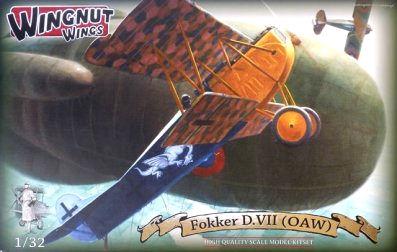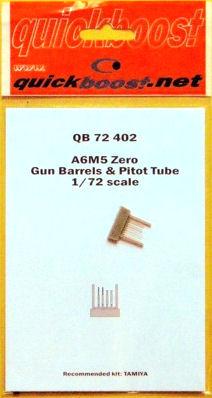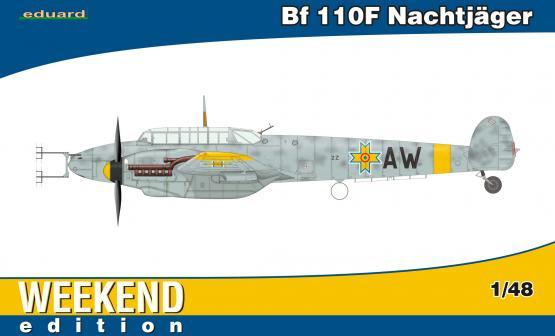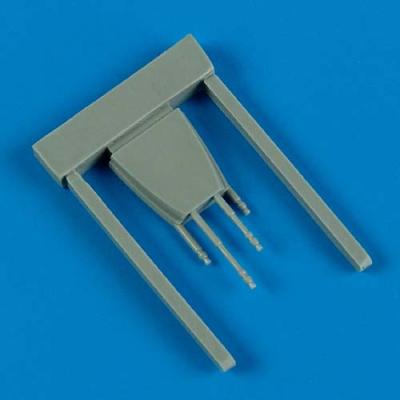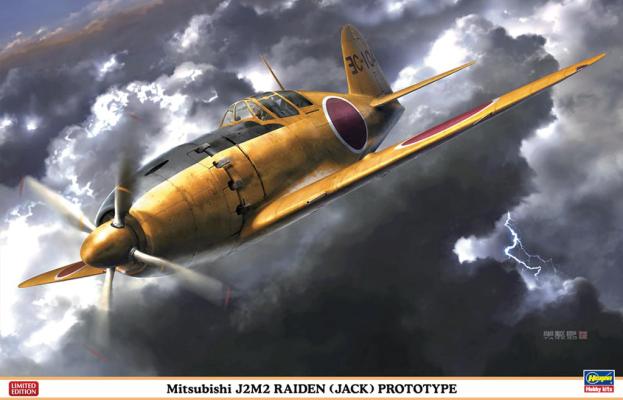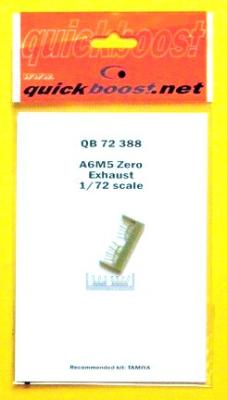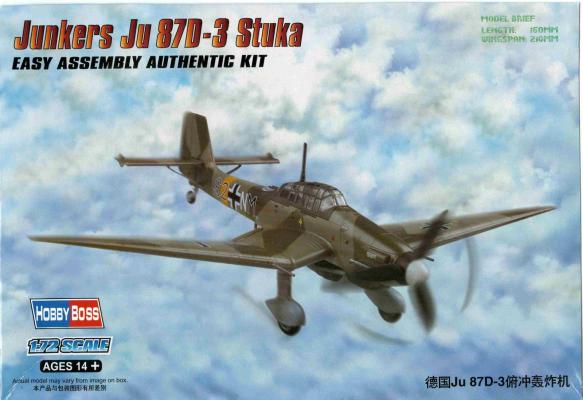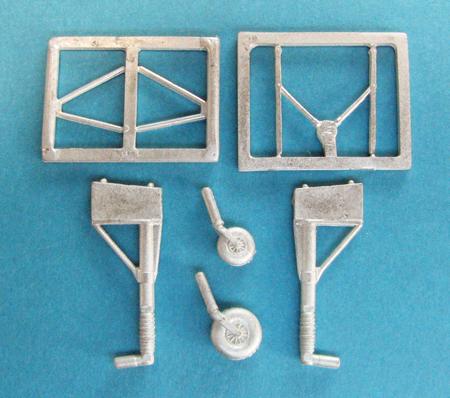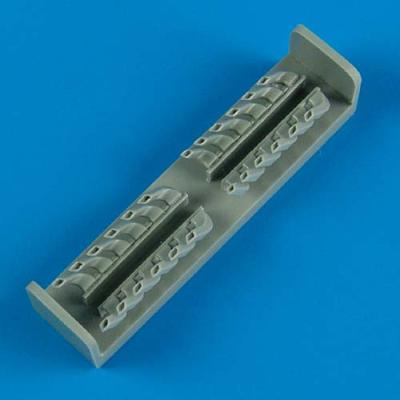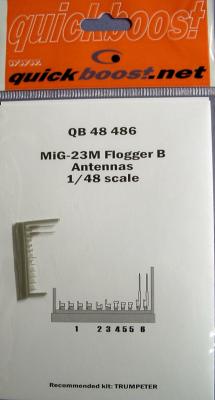The D.VII is my first go at a Wingnut Wings (WNW) kit, and I chose it for several reasons. The D.VII is one of the most recognizable aircraft used in World War I, perhaps even more so than the Dr. I. That having been said, the most significant feature that put this kit above the other WNW offerings for me was the sparse rigging that would be required. I don’t mind rigging per se, having tackled a number of 1/48th kits that are fully rigged, but I did not want to make my initial WNW project any more difficult or complex than it needed to be by adding rigging to the process.
Quickboost now offers model builders an aftermarket detail set that replaces the wing gun barrels and pitot tube found in Tamiya’s 1/72 A6M5 kit. The parts provide a higher level of detail and accuracy, and the gun barrels are molded with open ends. The parts are designed simply to drop-in, in place of the kit part, and provide better detail.
The parts are molded in Quickboost’s familiar resin on a small casting block with protective bars on the ends. The quality of the molding is quite flawless, with no bubbles, pinholes, or flash to deal with. A sharp #11 X-Acto blade or razor saw blade is the only tool needed to remove the parts from the casting block, and a quick swipe with a sanding stick can dress up the cut, if necessary. Because they are resin, they must be anchored with superglue or epoxy cement.
These detail parts will be a very nice addition to the 1/72 scale Tamiya 1/72 A6M5 kit. This set is highly recommended.
The Bf-110F was a transitional aircraft. It was put in place with the failure of the Me-210. It was an interim until the G-2 could be produced in numbers. Only 500 were made, divided between night fighters and fighter bombers.
Interestingly, Eduard elected to release the F as a weekend edition. This is the first time that the Bf-110F has been available in any scale that I know of. This cardboard box is so jam-packed with plastic it is surprising to me that it costs so little. Because of the transitional status of the real aircraft, it had features of the older E model and the newer still-to-come G model. Eduard’s parts break down shows this transitional parts listing, necessitating the parts from each of the earlier releases. There are a lot of extra parts because of it, even extra fuselage halves.
Quickboost has produced a set of resin gun barrels to replace the nose armament for the Eduard Bf-110E kit. The only real differences between the kit and replacement parts are that the resin part is one piece, whereas the kit parts need to be glued together, and the gun barrels are drilled out, allowing for more realism. Once installed, the gun barrels are barely visible, although the drilled out muzzles do stand out, and the parts are so small that drilling them out could be a bit tedious at best.
This is a nice little addition to what is already an excellent kit. Recommended. My thanks to Quickboost and to IPMS/USA for the opportunity to review these items.
The J2M series of aircraft were designed by Dr. Jiro Horikoshi who also was responsible for the Zero / Zeke design. The J2M (Allied code name “Jack”) was designed in 1939 and first flown in March of 1942. A total of 621 J2M Raiden (Japanese for Thunderbolt) series of aircraft J2M1 through J2M6 were produced with the M2 and M3 accounting for 438 of the total built.
Quickboost now offers model builders an aftermarket detail set that replaces the exhaust pipes found in Tamiya’s great 1/72 A6M5 kit. As nice as the kit parts may be, these pipes provide greater detail than those in the kit because Quickboost has molded them with open ends. They are designed to simply drop in, in place of the kit parts. As the photo below shows, they match up with the kit parts exactly so adding them to the model should be a simple matter after they are removed from the casting block.
History
When Ernst Udet brought back two Curtiss Hawk biplanes to Germany in the middle thirties after witnessing dive bombing demonstrations by US Navy pilots, he started a trend that resulted in the development of dive bombing aircraft for the Luftwaffe that eventually resulted in the development of the Junkers JU-87. Capable of nearly vertical dives retarded by very effective dive brakes, bombing accuracy improved dramatically, and during World War II, the Germans, along with the Americans and Japanese, developed dive bombing to a fine art. The Ju-87 was an early attempt at a specialized dive bomber, and although progressively developed during the war, could never keep pace with or coexist in an environment with enemy fighters unless a strong friendly fighter escort was present, a luxury the Germans didn’t always have.
This is a set of white metal landing gear struts for the Eduard 1/72nd scale Bf-110E kit. The unit consists of two main gear legs, which are identical to those in the kit, two different sized tail wheels, and two sets of bracing struts. I think the smaller tail wheel would fit a Bf-109 quite nicely. No instructions were provided. There were attachment tabs on the main gear, but none for the struts, which need to be secured with superglue. In this case, I felt that the kit units were adequate, so I didn’t use these, although they might prove useful on that old Monogram kit I have been eyeing on my shelf. The larger tail wheel, however, is quite nice, and has better tire tread detail than the one in the kit. I used it on my Eduard review kit.
Recommended. My thanks to Scale Aircraft Conversions and IPMS/USA for the chance to review this item.
This is a set of resin exhaust stacks for the new Eduard Bf-110E kit. The advantage in using these units is that they are drilled out, whereas the kit parts are not. They fit perfectly, and were a welcome addition to my model. They are to be installed after painting the basic structure, allowing for such detailing and weathering as you desire. These are worth getting to upgrade your model. Recommended.
My thanks to Quickboost and IPMS/USA for the opportunity to review this item.
Note: the packaging of this set indicates that it is antennas. In fact the details are antennas and pitot tubes.

